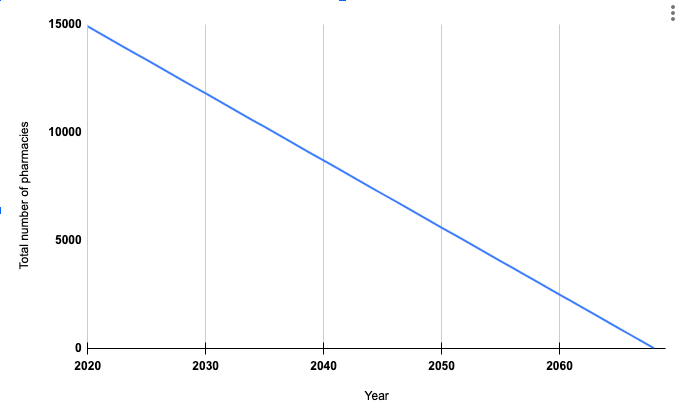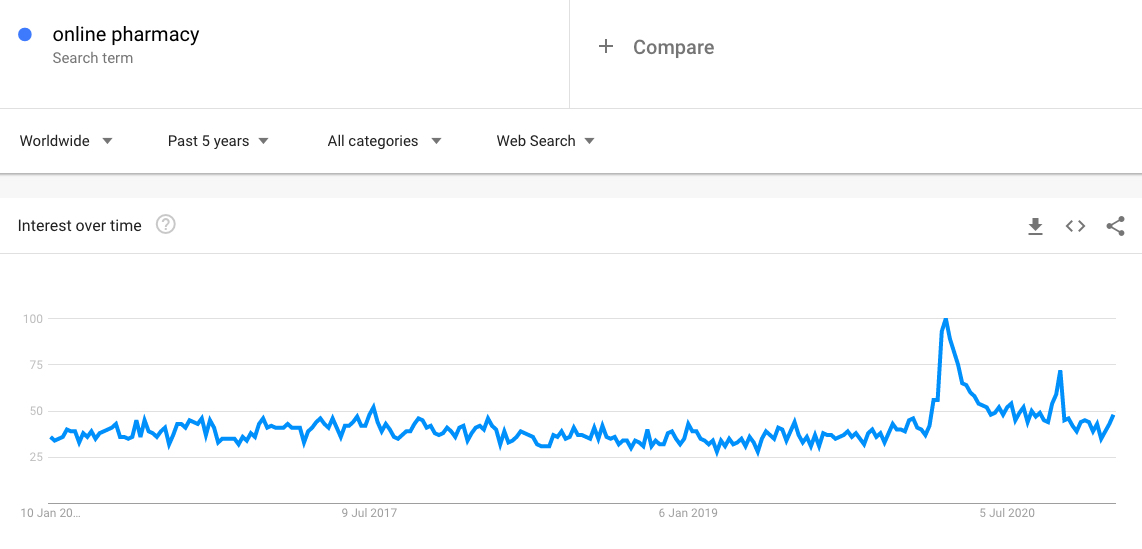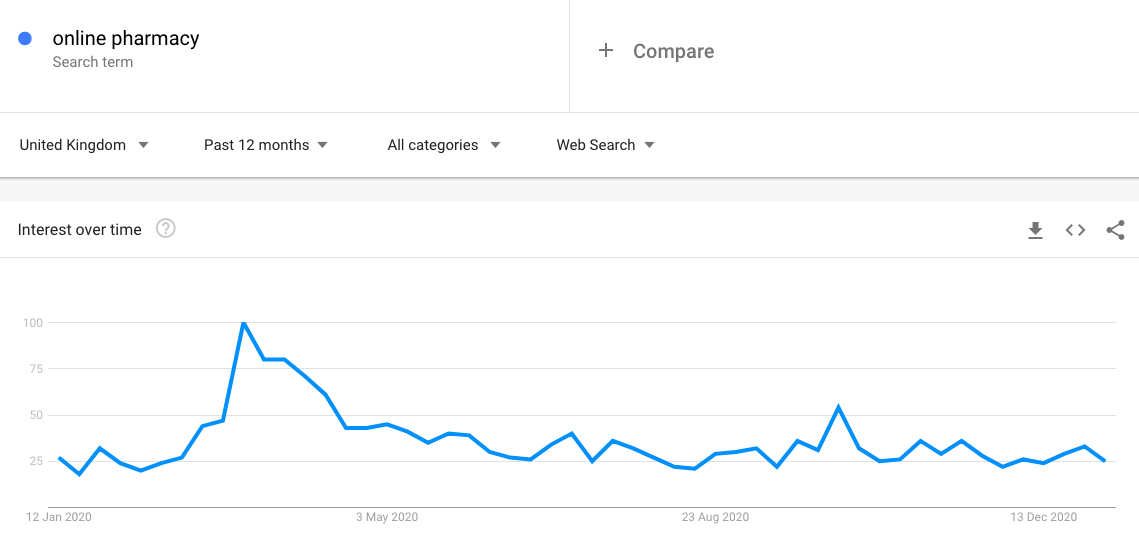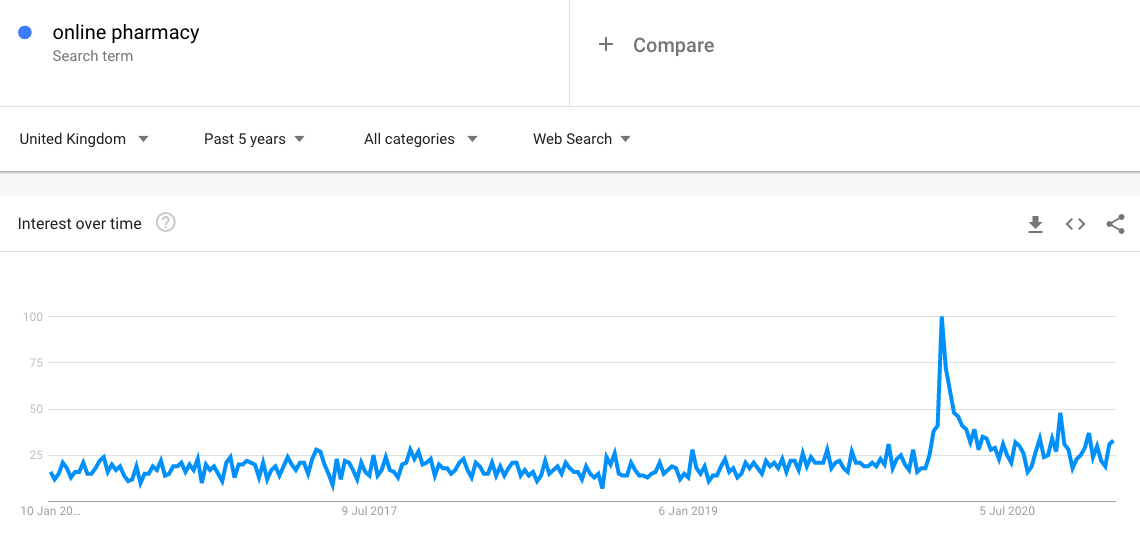Pharmacy Blackspots of the UK

After just a fifth of the way into the Department of Health and Social Care’s five year funding freeze for pharmacies, the necessity of community pharmacies and dispensaries has been thrown into question once again.
While the COVID-19 vaccines are a hugely positive step in the right direction for recovering from the ongoing pandemic, administering it presents a logistical conundrum and pharmacies play an important role.
But the reality remains that pharmacies have been on the decline - in part due to what the government has referred to as clustering, where multiple pharmacies exist within a 10 minute walk of one another. Clustering was the driving force behind the decision to cut funding to the pharmacy sector, and the reason why funding isn’t set to increase again, if at all, until 2024.
In this report by Medicine Direct, we have pulled pharmacy data for 16,794 pharmacies in England, Scotland and Northern Ireland over 3 years. Our analysis aimed to understand the prevalence and availability of pharmacies around the UK, how those numbers are changing and what the future of the high street pharmacy holds.
As an online clinic, we also recognise that - as with many high street staples - pharmacies are, for many of their customers, being usurped by their online counterparts, with clear pros and cons. In this report, we will allow the data to tell the story, revealing the true state of Britain’s pharmacies in 2021 and beyond.
The last pharmacy in England will close permanently within our lifetime
The number of pharmacies on Britain’s streets has been on the decline for a number of years. The data shows that the rate of decline is increasing in all areas of the UK and while some locations retain more than others, we have been able to extrapolate that data to show the date that the last pharmacy In England will close its doors.
That date is January 2069 - 48 years from now.
Analysis of data from NHS Digital reveals there were a total of 14,936 pharmacies open in England as of November 2020. But, if the current rate of closures is to be maintained by 2046 (25 years from now) there will be less than half the number of pharmacies that exist today.
Based on closures and new openings across England, there has been a net loss of 310 pharmacies each year - or 26 per month, on average for the last two years. Here’s how that looks across the country as a whole:

Of course, rates of decline can flex and the COVID-19 pandemic may well bolster the industry. With that said, recent reports of Lloyds Pharmacy closing many of its branches suggest that, regardless of the pandemic, the stark finding that there could be no pharmacies left within our lifetime stands true.
Residents of Salisbury, Hereford and Reading face greatest challenges in access to pharmacies
Our analysis sought to understand the availability of pharmacies across the UK. This meant using pharmacy data relating to each specific postcode and analysing it alongside population data to reveal the number of people served by each pharmacy. The higher that number, the less accessible the pharmacy is considered to be.
|
Postcode area |
Area covered |
Population |
Households |
Number of Pharmacies |
Pharmacies Per 100,000 People |
People Per Pharmacy |
|
SP |
Salisbury |
232282 |
94658 |
39 |
16.79 |
5,956 |
|
HR |
Hereford |
176308 |
75400 |
32 |
18.15 |
5,510 |
|
RG |
Reading |
778419 |
314408 |
150 |
19.27 |
5,189 |
|
SN |
Swindon |
458798 |
191252 |
92 |
20.05 |
4,987 |
|
SO |
Southampton |
665472 |
276330 |
135 |
20.29 |
4,929 |
|
TA |
Taunton |
322408 |
139414 |
67 |
20.78 |
4,812 |
|
LN |
Lincoln |
293141 |
126372 |
61 |
20.81 |
4,806 |
|
TR |
Truro |
294061 |
127803 |
62 |
21.08 |
4,743 |
|
DT |
Dorchester |
212796 |
93053 |
45 |
21.15 |
4,729 |
|
WR |
Worcester |
287838 |
122730 |
61 |
21.19 |
4,719 |
|
TN |
Tonbridge |
681747 |
286228 |
147 |
21.56 |
4,638 |
|
HG |
Harrogate |
138214 |
59455 |
30 |
21.71 |
4,607 |
|
BA |
Bath |
434539 |
183530 |
95 |
21.86 |
4,574 |
|
GU |
Guildford |
726120 |
288537 |
159 |
21.90 |
4,567 |
The table here shows the total number of pharmacies available per 100,000 members of the population of each postcode area, and the number of people served by each pharmacy.
It shows the 15 locations with the fewest pharmacies per person and the highest number of people per pharmacy - the worst affected locations for pharmacy access.
Residents of London, Lerwick, Watford and the Outer Hebrides have the best access to pharmacies
According to our study, residents of London, Lerwick, Watford and the Outer Hebrides have the best access to pharmacies, as shown in the table below:
|
Postcode area |
Area covered |
Population |
Households |
Number of Pharmacies |
Pharmacies Per 100,000 People |
People Per Pharmacy |
|
EC |
Central London |
33,956 |
17,102 |
30 |
88 |
1,132 |
|
WC |
Central London |
35,745 |
15,757 |
21 |
59 |
1,702 |
|
ZE |
Lerwick |
23,086 |
9,915 |
12 |
52 |
1,924 |
|
W |
West London |
531,690 |
236,493 |
251 |
47 |
2,118 |
|
HA |
Harrow |
480,678 |
169,132 |
208 |
43 |
2,311 |
|
WD |
Watford |
256,476 |
103,336 |
108 |
42 |
2,375 |
|
HS |
Outer Hebrides |
27,663 |
12,565 |
11 |
40 |
2,515 |
|
NW |
North West London |
553,732 |
222,208 |
219 |
40 |
2,528 |
|
BD |
Bradford |
578,374 |
223,952 |
221 |
38 |
2,617 |
|
BB |
Blackburn |
488,564 |
202,015 |
185 |
38 |
2,641 |
|
KW |
Kirkwall |
53,132 |
24,290 |
20 |
38 |
2,657 |
|
HX |
Halifax |
160,137 |
68,980 |
56 |
35 |
2,860 |
|
N |
North London |
847,197 |
344,938 |
296 |
35 |
2,862 |
|
OL |
Oldham |
462,590 |
188,194 |
160 |
35 |
2,891 |
|
B |
Birmingham |
1,904,293 |
750,842 |
652 |
34 |
2,921 |
As shown here, the number of pharmacies per 100,000 residents is greatest in London. Outside of the capital, locations in the north also rank highly - with Bradford, Blackburn, Halifax and Oldham all having fewer than 3,000 residents per pharmacy.
Pharmacy access by country
The number of pharmacies available to serve each 100,000 people in an area is a metric which makes the numbers comparable, regardless of location size. We analysed the data to find out which areas have the best and worst access to pharmacies in England, Scotland and Northern Ireland - with a higher number of pharmacies per 100,000 a quantifier of greater access.
The areas of England with the best access to pharmacies are:
- London
- Yorkshire
- Lancashire
Central London has the greatest access to pharmacies in England. Outside of London, Yorkshire and Lancashire have some of the best access in the country, with Bradford and Halifax in Yorkshire and Blackburn and Oldham in Lancashire.
The areas of England with the worst access to pharmacies are:
- Salisbury
- Hereford
- Reading
Edinburgh has the worst access to pharmacies in Scotland
The location in Scotland with the best access to pharmacies is Lerwick, with 52 pharmacies per 100,000. The location with the worst access is Edinburgh, with just 22 pharmacies per 100,000.
|
Postcode area |
Area covered |
Population |
Number of Pharmacies |
Pharmacies Per 100,000 |
People Per Pharmacy |
|
ZE |
Lerwick |
23,086 |
12 |
52 |
1924 |
|
HS |
Outer Hebrides |
27,663 |
11 |
40 |
2515 |
|
KW |
Kirkwall |
53,132 |
20 |
38 |
2657 |
|
PA |
Paisley |
321,350 |
99 |
31 |
3246 |
|
DG |
Dumfries and Galloway |
151,139 |
46 |
30 |
3286 |
|
IV |
Inverness |
228,056 |
66 |
29 |
3455 |
|
PH |
Perth |
165,118 |
45 |
27 |
3669 |
|
KA |
Kilmarnock |
370,877 |
101 |
27 |
3672 |
|
FK |
Falkirk and Stirling |
276,371 |
72 |
26 |
3838 |
|
G |
Glasgow |
1,183,614 |
302 |
26 |
3919 |
|
AB |
Aberdeen |
499,692 |
122 |
24 |
4096 |
|
KY |
Kirkcaldy |
363,956 |
85 |
23 |
4282 |
|
ML |
Motherwell |
382,997 |
88 |
23 |
4352 |
|
DD |
Dundee |
280,568 |
63 |
22 |
4453 |
|
EH |
Edinburgh |
868,113 |
192 |
22 |
4521 |
In Edinburgh, there are more females than males and the average age is 25-44. In another study, it was shown that females are more likely to visit a pharmacy for advice as well as medication - meaning the decline in pharmacies in Edinburgh will impact that section of the population more than most.
The average lifespan of an English pharmacy
By analysing the year in which nearly 15,000 English pharmacies opened and the year they closed (if applicable), we were able to find the average lifespan of pharmacies across the country.
The location where pharmacies stay open the longest based on this analysis is Romford, with a lifespan of 18 years. The top 15 locations by lifespan are shown here:
|
Postcode Area |
Area Covered |
Average Lifespan |
|
RM |
Romford |
18.07 |
|
LN |
Lincoln |
15.85 |
|
W |
West London |
15.78 |
|
DY |
Dudley |
15.28 |
|
HR |
Hereford |
14.88 |
|
B |
Birmingham |
14.87 |
|
CH |
Chester |
14.80 |
|
DA |
Dartford |
14.75 |
|
LA |
Lancaster |
14.59 |
|
WD |
Watford |
14.54 |
|
SN |
Swindon |
14.41 |
|
SM |
Sutton |
14.24 |
|
NW |
North West London |
14.09 |
|
CA |
Carlisle |
13.95 |
|
UB |
Southall |
13.80 |
The location where pharmacies have the shortest lifespan on average is Taunton, at just over 7 years. The table here shows the bottom 15 locations based on lifespan:
|
Postcode Area |
Area Covered |
Average Lifespan |
|
TA |
Taunton |
7.88 |
|
DT |
Dorchester |
7.94 |
|
CO |
Colchester |
8.19 |
|
PE |
Peterborough |
8.54 |
|
RG |
Reading |
8.85 |
|
HD |
Huddersfield |
8.85 |
|
CM |
Chelmsford |
8.90 |
|
BD |
Bradford |
9.03 |
|
YO |
York |
9.17 |
|
TQ |
Torquay |
9.48 |
|
HX |
Halifax |
9.49 |
|
CT |
Canterbury |
9.52 |
|
PR |
Preston |
9.71 |
|
MK |
Milton Keynes |
9.72 |
|
DN |
Doncaster |
9.76 |
The rise of the online pharmacy
When it comes to alternatives to physical pharmacies, interest in online pharmacies has been growing over time. According to Google’s own data, searches for the term “online pharmacy” has grown significantly worldwide through 2020:

This is a trend that is clearly correlated with the lockdowns in 2020, as shown here:

In the UK specifically, the number of searches for “online pharmacy” has also spiked in 2020:

As we have seen with physical bank branches closing due to people doing their banking online, more people are turning to online pharmacies for the convenience of being seen almost immediately and having their medicine with them the very next day.
For many people that suffer with chronic conditions it is also a safer option, particularly for individuals that require asthma treatments and high blood pressure treatments who have been advised to take extra caution during the pandemic due to the added risk of their condition. It’s also beneficial for those who might feel uncomfortable or have anxiety about visiting a physical pharmacy for certain conditions such as those relating to sexual health or chronic conditions such as IBS, or for those requiring pain relief where they may not want to leave their home for treatment.
Many pharmacies are now employing Pharmacy Independent Prescribers (PIPs), who are qualified to prescribe medication for practically any condition without needing to see the patient face to face.
Online pharmacies that use this method allow their customers to receive their medicine without needing to leave the house, or wait to get see their GP - something that is a ‘nice to have’ in the current climate and essential as pharmacies meet their final closure dates.
What do these findings mean for the future of the pharmacy?
Our analysis of the number of pharmacies in the UK today has revealed some stark truths - not least the imminent decline of pharmacies on our streets, with the final pharmacy closing its doors well within our lifetimes.
In another report, we also hhighlighted the areas of the UK with the best and worst access to a community pharmacy and the impact this may have on the vaccine rollout.
With a mean average age above the national average and a higher percentage of residents in the 85+ age range, Salisbury has the lowest number of pharmacies per 100,000 people (other than Galashiels, which can be assumed as an anomaly due to a smaller than average population representation within their postcode).
Older residents are at higher risk of illness requiring medication and typically have a lower propensity to use online channels as an alternative - meaning that moving forward, those residents will need both education and support in accessing the medicines they need as their access to physical pharmacies declines.
Individuals that suffer from chronic conditions and need their medication on a monthly basis may also need to look at online pharmacies as a way to ensure their monthly medication needs are met. Individuals that suffer from any chronic condition are naturally at a higher risk of illness and need to take extra precation especially during a pandemic.
Of course, the rise of online pharmacies is a solution to this challenge, but only where proper education and support is provided to those who need it most. Consumers will need to learn to trust online providers - and in turn, those online providers will need to be trustworthy.
While there will always be a need for doctor’s surgeries and physical pharmacies for many conditions, the shift to online will continue to expand in the coming years. The coronavirus has pushed this trend forward in a way that nobody could have expected, with countless people being made aware of the convenience and ease of use that an online pharmacy can provide.
Greater forms of identity verification will need to start playing a part in the online healthtech world. It is vital that all pharmacies know who they are serving when they receive inquiries, to avoid selling medicines to people who do not really need them. Systems and software to properly check each person’s identity is an essential component in providing safe healthcare for all. Online pharmacies must have systems in place to weed out the false cases and prevent fake accounts from being set up.
Online pharmacies will also need to dedicate themselves to building trust with their patients. The online pharmacy world is still in its infancy, with many people still having reservations about the idea of being treated online. This is understandable after centuries of visiting a trusted local doctor, but it is the responsibility of the pharmacy to reassure those who shop with them that they are ordering safe, approved and genuine versions of the medication they require.
Online pharmacists and doctors will still need the same friendly, community-minded manner that a local GP would have. This is essential for putting people at ease and encouraging them to use this convenient and safe form of healthtech.
There are few industries left that don’t need to keep up with the digital transformation, and healthcare is no exception. To continue to thrive in the digital age, community pharmacies will need to begin to establish an online presence so that their local customers can get in touch with them.
In many ways, the coronavirus hastened the digital surge for healthcare. So many people who had never used an online pharmacy before have been forced to turn to them during the pandemic due to lack of doctor appointments and restrictions. Looking ahead, the online pharmacy is here to stay.
Methodology
To work out when the last pharmacy in England would close we looked at data from NHS Digital which showed there were a total of 14,936 pharmacies open in England in November 2020. Analysis of the data showed 1,200 pharmacies had closed since the start of 2019 with 614 pharmacies opening (a net loss of 586 pharmacies).
We then worked out if the current rate of pharmacy closures for the last 10 months (since the start of 2020) continued to the end of 2020 an additional 86 would shut with 53 opening (a net loss of 33 pharmacies). We could then predict at the end of 2020 there were a total of 14,903 pharmacies open. That would mean a total of 1,286 pharmacies have closed in the last two years with 667 pharmacies opening (a net loss of 619 pharmacies - 309.5 each year). We rounded this number up to 310 and calculated if 310 pharmacies continued to close each year there would be no pharmacies left in England by the end of January 2069.
Pharmacies are closing in their numbers at a rapid rate throughout Britain. Which cities have the best and worst access to community pharmacies. Analysing data taken from 16,794 pharmacies in England, Scotland, Wales and Northern Ireland we aim to understand what the future of the high street pharmacy holds and which areas are the hardest hit by pharmacy closures in Britain.








